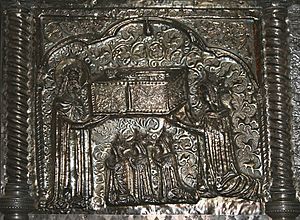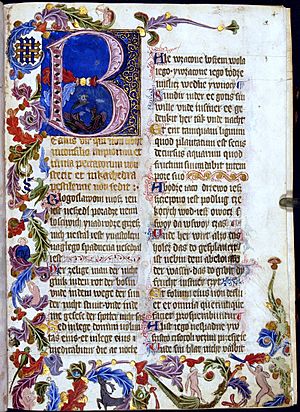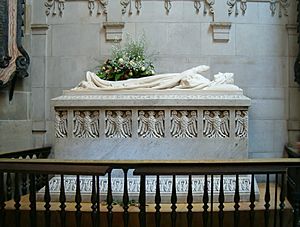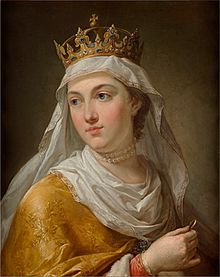Jadwiga of Poland facts for kids
Quick facts for kids Jadwiga |
|
|---|---|

Effigy of Jadwiga on her seal
|
|
| Queen of Poland with Władysław II Jagiełło (1386–1399) |
|
| Reign | 16 October 1384 – 17 July 1399 |
| Coronation | 16 October 1384 Wawel Cathedral, Kraków |
| Predecessor | Louis |
| Successor | Władysław II Jagiełło |
| Born | between 3 October 1373 and 18 February 1374 Buda, Hungary |
| Died | (aged 25) Kraków, Poland |
| Burial | 24 August 1399 Wawel Cathedral, Kraków |
| Spouse | Władysław II Jagiełło (Jogaila) |
| Issue | Elizabeth Bonifacia |
| House | Capetian House of Anjou |
| Father | Louis I of Hungary |
| Mother | Elizabeth of Bosnia |
| Religion | Catholic |
Jadwiga (born 1373 or 1374 – died 17 July 1399) was the first woman to be crowned as a monarch of the Kingdom of Poland. She ruled from October 16, 1384, until her death.
When she was young, it was planned that Jadwiga would marry William of Austria. She even lived in Vienna for a few years. Her father, King Louis I, wanted his daughters to inherit his kingdoms because he had no sons. After her older sister Catherine died, many thought Jadwiga and William would rule Hungary. However, when King Louis died in 1382, her other sister, Mary, was crowned "King of Hungary."
Meanwhile, in Poland, the nobles wanted a ruler who would live in Poland. Jadwiga's mother, Queen Elizabeth, chose Jadwiga to rule Poland. Jadwiga was crowned king in Kraków, Poland's capital, on October 16, 1384. This showed that the Polish nobles wanted her to be the true ruler.
Jadwiga's advisors then started talks with Jogaila, the Grand Duke of Lithuania. He was not yet Christian. Jogaila agreed to become Catholic and convert his people if he married Jadwiga. William of Austria tried to marry Jadwiga, but Polish nobles sent him away.
Jogaila became Catholic, taking the name Władysław. He married Jadwiga on February 15, 1386. Władysław Jagiełło was crowned King of Poland on March 4, 1386, ruling alongside Jadwiga. They worked together, but Jadwiga's political power was limited.
Jadwiga helped Poland grow. She led an army into the Kingdom of Galicia–Volhynia, which was under Hungarian rule, and convinced its people to join Poland. She also helped settle disagreements between her husband's family and between Poland and the Teutonic Knights.
After her sister Mary died in 1395, Jadwiga and Jogaila claimed the throne of Hungary. However, the Hungarian lords did not support them. Jadwiga died four years later. In 1997, she was made a saint by the Catholic Church.
Contents
Early Life and Marriage Plans (1373–1382)

Jadwiga was born in Buda, the capital of the Kingdom of Hungary. She was the youngest of three daughters of Louis I, who was King of both Hungary and Poland. Her mother was Elizabeth of Bosnia.
King Louis had no sons, so he wanted to make sure his daughters could inherit his lands. This made his daughters very desirable brides for other royal families. When Jadwiga was very young, in 1374, Leopold III, Duke of Austria, suggested his son, William, marry Jadwiga. King Louis agreed in 1375.
A "provisional marriage" ceremony took place in Hainburg in 1378. After this, Jadwiga lived in Austria for almost two years, mostly in Vienna. This promised marriage was confirmed again in 1380. Hungarian lords also agreed, suggesting Jadwiga and William were seen as future rulers of Hungary.
Becoming Queen of Poland
Her Coronation (1384)
On October 16, 1384, after King Louis's death, Archbishop Bodzanta crowned Jadwiga as the new king of Poland. Important church leaders and nobles became her trusted advisors. Some historians believe Jadwiga, being so young, was mostly guided by her advisors. However, others say she quickly became strong and her kind personality helped her rule.
The Polish nobles did not want Jadwiga's fiancé, William of Habsburg, to become their king. They thought William was too young and that his Austrian family could not protect Poland well. The nobles of Lesser Poland were the first to suggest that Jadwiga should marry Jogaila, the pagan duke of Lithuania.
Jogaila sent his representatives to Kraków in January 1385 to ask for Jadwiga's hand in marriage. Jadwiga said her mother would decide. Jogaila's envoys then met Queen Elizabeth, who said she would agree to whatever was best for Poland and Christianity. The Polish nobles met and most agreed to Jogaila's marriage proposal.

Meanwhile, William's father rushed to Hungary in July 1385. Queen Elizabeth confirmed the earlier marriage plans. William went to Kraków in August, but he was not allowed into Wawel Castle. It is said that Jadwiga and William could only meet in a nearby church building.
A story says that Polish noblemen broke into the castle and forced William to flee. After this, Jadwiga wanted to leave Wawel to join William, but the castle gate was locked. She supposedly called for an axe to break it open, but a nobleman named Dymitr of Goraj convinced her to return. William of Austria was then forced to leave Poland.
Marriage to Jogaila (1385–1392)

In August 1385, Jogaila signed the Union of Krewo. He promised to become Catholic, along with his family and people, if he married Jadwiga. He also agreed to pay money to William of Habsburg as compensation, but William never accepted it.
The Polish nobles told Jogaila they would obey him if he married Jadwiga. Jogaila went to Lublin, where an assembly declared him "king and lord of Poland." He then went to Kraków and was baptized, taking the Christian name Władysław, on February 15. Three days later, 35-year-old Władysław-Jogaila married 12-year-old Jadwiga.
Archbishop Bodzanta crowned Władysław-Jogaila king on March 4, 1386. Poland became a kingdom ruled by two monarchs. Jadwiga and her husband did not speak the same language, but they worked closely together.
Challenges and Diplomacy (1392–1399)
Jadwiga's brother-in-law, Sigismund, who was King of Hungary, began talking with the Teutonic Knights about dividing Poland. Jadwiga was a skilled diplomat, known for being fair and smart. She traveled to Lithuania to help make peace between her husband's relatives.
Relations between Poland and Hungary remained tense. Sigismund invaded Moldavia, forcing its ruler to accept his authority. Soon after, Moldavia's ruler sent envoys to Jadwiga and Jogaila, promising to help Poland against Hungary and the Teutonic Knights.
On May 17, 1395, Jadwiga's sister Mary died after a riding accident. According to an earlier agreement, Jadwiga was Mary's heir in Hungary. However, the powerful Hungarian lords did not support Jadwiga's claim. They declared they would not change rulers while Sigismund was away fighting the Ottoman Turks. Jadwiga took the title "heir to Hungary" but did not take further action.
The relationship between Lithuania and the Teutonic Knights was also difficult. Jadwiga and her Polish advisors invited the Grand Master of the Teutonic Knights to Poland for talks in 1396. Jadwiga also faced conflicts with other nobles who claimed parts of Poland. To show these lands were under her direct control, Władysław-Jogaila gave the Duchy of Belz and Cuyavia to her in 1397.
Jadwiga wanted to avoid war with the Teutonic Order. She also worked to establish a college for Lithuanian students in Prague. She issued a charter for the college in November 1397, showing how much she cared about this project.
Pregnancy and Death (1399)

Jadwiga had been childless for over ten years. She became pregnant in late 1398 or early 1399. Her husband's cousin, Vytautas, the Grand Duke of Lithuania, sent expensive gifts for the expected baby, including a silver cradle.
A baby girl was born on June 22, 1399, at Wawel Castle. Reports said the child was born early. The princess was named Elizabeth Bonifacia, after Jadwiga's mother and Pope Boniface IX, who agreed to be godfather. She was baptized by the Bishop of Kraków.
Sadly, the infant died after only three weeks, on July 13, 1399. Jadwiga also became very ill. A scholar named Stanisław of Skarbimierz hoped she would live, calling her a "spiritual mother" to the poor and sick in Poland. Jadwiga advised her husband to marry Anna of Cilli, a granddaughter of Casimir the Great. Jadwiga died on July 17, 1399, just four days after her daughter.
Jadwiga and her daughter were buried together in Wawel Cathedral on August 24, 1399, as Jadwiga had wished.
Family
| Ancestors of Jadwiga of Poland | |||||||||||||||||||||||||||||||||||||||||||||||||||||||||||||||||||||||||||||||||||||||||||||||||||||||||||||||||||||||||||||||||||||||||||||||||||||||||||||||||||||||||||||||||||||||||||||||||||||||||||||||||||||||||||||||||||||||||||||||||||||||||||||||||||||||||||||||||||||||||||||||||||||||||||||||||||||||||||||||||||||||||||||||||||||||||||||||||||||||||||||||||||||||||||||||||||||||||||||||||||||||||||||||||||||||||||||||||||||||||||||||||||||||||||||||||||||||||||||||||||||||||||||||||||||||||||||||||||||||||||||||||||||||||||||
|---|---|---|---|---|---|---|---|---|---|---|---|---|---|---|---|---|---|---|---|---|---|---|---|---|---|---|---|---|---|---|---|---|---|---|---|---|---|---|---|---|---|---|---|---|---|---|---|---|---|---|---|---|---|---|---|---|---|---|---|---|---|---|---|---|---|---|---|---|---|---|---|---|---|---|---|---|---|---|---|---|---|---|---|---|---|---|---|---|---|---|---|---|---|---|---|---|---|---|---|---|---|---|---|---|---|---|---|---|---|---|---|---|---|---|---|---|---|---|---|---|---|---|---|---|---|---|---|---|---|---|---|---|---|---|---|---|---|---|---|---|---|---|---|---|---|---|---|---|---|---|---|---|---|---|---|---|---|---|---|---|---|---|---|---|---|---|---|---|---|---|---|---|---|---|---|---|---|---|---|---|---|---|---|---|---|---|---|---|---|---|---|---|---|---|---|---|---|---|---|---|---|---|---|---|---|---|---|---|---|---|---|---|---|---|---|---|---|---|---|---|---|---|---|---|---|---|---|---|---|---|---|---|---|---|---|---|---|---|---|---|---|---|---|---|---|---|---|---|---|---|---|---|---|---|---|---|---|---|---|---|---|---|---|---|---|---|---|---|---|---|---|---|---|---|---|---|---|---|---|---|---|---|---|---|---|---|---|---|---|---|---|---|---|---|---|---|---|---|---|---|---|---|---|---|---|---|---|---|---|---|---|---|---|---|---|---|---|---|---|---|---|---|---|---|---|---|---|---|---|---|---|---|---|---|---|---|---|---|---|---|---|---|---|---|---|---|---|---|---|---|---|---|---|---|---|---|---|---|---|---|---|---|---|---|---|---|---|---|---|---|---|---|---|---|---|---|---|---|---|---|---|---|---|---|---|---|---|---|---|---|---|---|---|---|---|---|---|---|---|---|---|---|---|---|---|---|---|---|---|---|---|---|---|---|---|---|---|---|---|---|---|---|---|---|---|---|---|---|---|---|---|---|---|---|---|---|---|---|---|---|---|---|---|---|---|---|---|---|---|---|---|---|---|---|---|---|---|---|---|---|---|---|---|---|---|---|---|---|---|---|---|---|---|---|---|---|---|---|---|---|---|---|---|---|---|---|---|---|---|---|---|---|---|---|---|---|---|---|---|---|---|---|---|---|---|---|---|---|---|---|---|---|---|---|---|---|---|---|---|---|---|---|---|---|---|---|---|---|---|---|---|---|---|---|---|---|---|---|---|---|---|
|
|||||||||||||||||||||||||||||||||||||||||||||||||||||||||||||||||||||||||||||||||||||||||||||||||||||||||||||||||||||||||||||||||||||||||||||||||||||||||||||||||||||||||||||||||||||||||||||||||||||||||||||||||||||||||||||||||||||||||||||||||||||||||||||||||||||||||||||||||||||||||||||||||||||||||||||||||||||||||||||||||||||||||||||||||||||||||||||||||||||||||||||||||||||||||||||||||||||||||||||||||||||||||||||||||||||||||||||||||||||||||||||||||||||||||||||||||||||||||||||||||||||||||||||||||||||||||||||||||||||||||||||||||||||||||||||
This family tree shows how Jadwiga was connected to her important relatives. Kings of Poland are shown in blue.
| Konrad I of Masovia | |||||||||||||||||||||||||||||||||||||||||||||||||||||||||||||||
| Casimir I of Kuyavia | Siemowit I of Masovia | ||||||||||||||||||||||||||||||||||||||||||||||||||||||||||||||
| Władysław the Elbow-high (r. 1320–1333) | Ziemomysł of Kuyavia | Bolesław II of Masovia | |||||||||||||||||||||||||||||||||||||||||||||||||||||||||||||
| Casimir the Great (r. 1333–1370) | Elizabeth of Poland | Casimir II of Kuyavia | Trojden I of Masovia | ||||||||||||||||||||||||||||||||||||||||||||||||||||||||||||
| Elizabeth of Poland | Elizabeth of Kuyavia | Władysław the White | Anna of Poland | Siemowit III of Masovia | |||||||||||||||||||||||||||||||||||||||||||||||||||||||||||
| Elizabeth of Pomerania | Louis the Great (r. 1370–1382) | Elizabeth of Bosnia | Siemowit IV of Masovia | ||||||||||||||||||||||||||||||||||||||||||||||||||||||||||||
| Sigismund of Luxemburg | Mary of Hungary | Jadwiga (r. 1384–1399) | Władysław-Jogaila (r. 1386–1434) | Anna of Cilli | |||||||||||||||||||||||||||||||||||||||||||||||||||||||||||
Legacy
Her Achievements
Historians agree that Jadwiga was one of Poland's greatest rulers. Her marriage to Władysław-Jogaila brought Poland and Lithuania together, creating a large and powerful state in Eastern Europe. Many Polish historians believe her decision to marry Jogaila instead of William was a great sacrifice for her country.
Jadwiga worked hard to keep peace with the Teutonic Order. This allowed Poland to prepare for future conflicts. After Jadwiga died without children, Władysław-Jogaila's position as king was weakened. However, the Polish nobles confirmed him as king again. They also asked him to marry Anna of Cilli, which he did in 1402.
Jadwiga also did a lot for culture and charity. She helped build new hospitals, schools, and churches. She also made sure that church services used the Polish language, especially for hymns. The Bible was even translated into Polish because of her.
Jadwiga played a key role in bringing back the University of Kraków. The university had been started earlier but closed after the founder's death. Jadwiga and Władysław-Jogaila asked the Pope to allow a theology department in Kraków. The Pope agreed in 1397. Jadwiga bought buildings for the university. The university was officially reopened in 1400, a year after her death. Jadwiga's jewelry was sold to help pay for its restoration, as she wished in her will.
Her Holiness
| Saint Jadwiga of Poland | |
|---|---|
| Venerated in | Catholic Church |
| Beatified | 8 August 1986, Kraków, Poland by Pope John Paul II |
| Canonized | 8 June 1997, Kraków, Poland by Pope John Paul II |
| Major shrine | Wawel Cathedral, Kraków, Poland |
| Feast | 17 July |
| Attributes | Royal dress and shoes, apron full of roses |
| Patronage | Poland, queens, united Europe, students, mothers |
Jadwiga came from a very religious family. She went to Mass every day and was especially devoted to the Virgin Mary. She had an inscription put on a special cup in Wawel Cathedral, asking Mary to protect Poland.
People in Poland began to honor Jadwiga as a saint soon after she died. Early writings described her as a very Christian queen, known for her kindness and generosity. Her help in restoring the University of Kraków was also often mentioned.
Many legends about miracles are told about Jadwiga:
- Jadwiga's Cross: Jadwiga often prayed before a large crucifix in Wawel Cathedral. It is said that Jesus on the cross spoke to her during one of these prayers. This crucifix, known as "Saint Jadwiga's cross," is still there.
- Jadwiga's Foot: Another story says Jadwiga gave a piece of jewelry from her shoe to a poor stonemason. When she left, her footprint appeared in the hardened plaster floor of his workshop. This "Jadwiga's foot" can still be seen in a church in Kraków.
- In another legend, during a procession, a boy fell into a river and drowned. Jadwiga threw her royal cloak over his body, and he came back to life.
On August 8, 1986, Pope John Paul II officially declared her "blessed." He then made her a saint in Kraków on June 8, 1997.
Images for kids
-
Dymitr of Goraj by Jan Matejko depicts Jadwiga trying to break the castle gate to join William
See also
 In Spanish: Eduviges I de Polonia para niños
In Spanish: Eduviges I de Polonia para niños
- History of Poland during the Piast dynasty
- History of Poland during the Jagiellonian dynasty
- Saint Hedwig of Poland, patron saint archive



